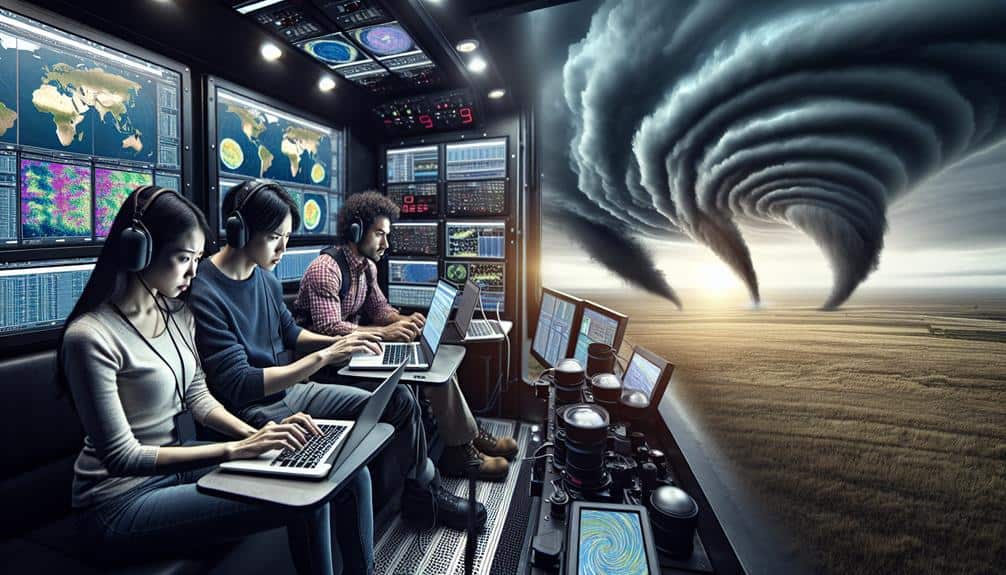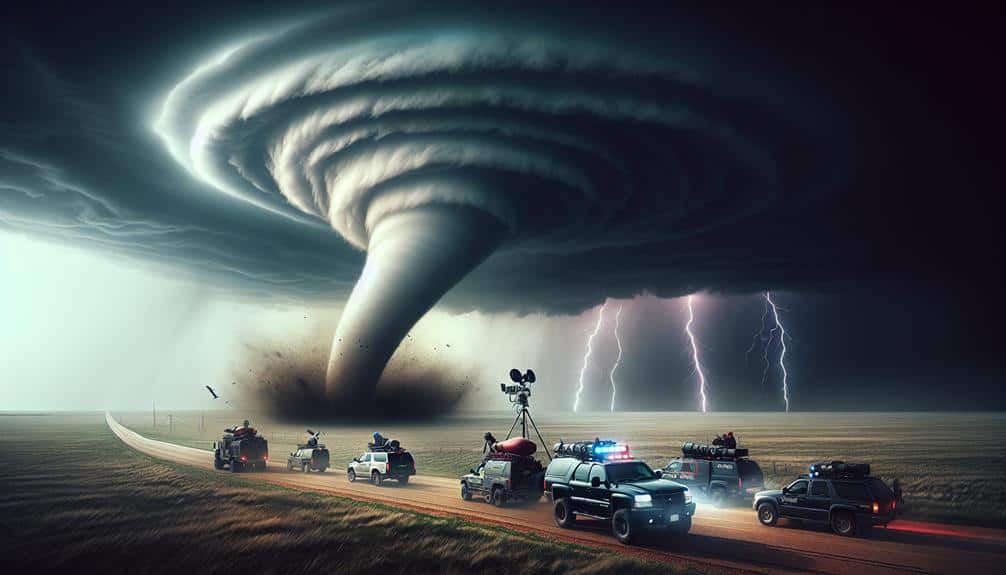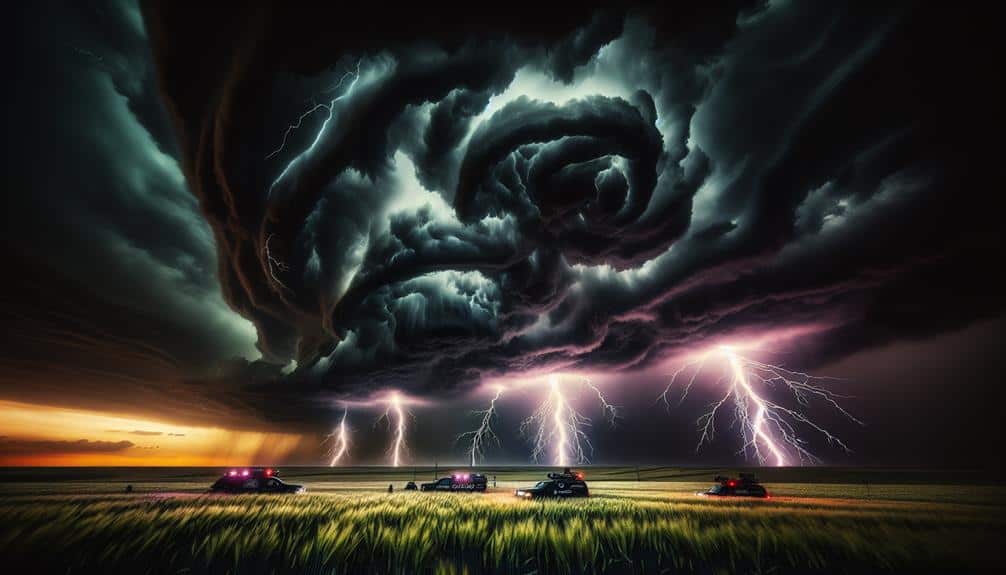As seasoned storm chasers, we prioritize strict safety protocols and equip our chase vehicles with essential safety gear and high-definition radar systems. We analyze synoptic-scale systems, utilize GFS and NAM models, and study Doppler radar and Skew-T log-P diagrams for real-time atmospheric data. Our team, consisting of a meteorologist, navigator, and driver, uses encrypted communication channels for seamless data sharing. We thoroughly understand contest rules to guarantee compliance and optimize our strategy. With regular vehicle maintenance checks and real-time communication with meteorological stations, our approach is methodical and data-driven. Let's explore these strategies further for a competitive edge.
Key Points
- Prioritize safety by ensuring all team members are trained in first aid and CPR and vehicles are equipped with essential safety gear.
- Study weather patterns extensively, utilizing tools like Doppler radar, satellite imagery, and numerical weather prediction models.
- Equip your vehicle with high-definition radar systems, professional-grade anemometers, and reliable power sources for all electronic equipment.
- Build a reliable team with designated roles, including a meteorologist, navigator, and driver, and establish effective communication protocols.
Prioritize Safety First
When storm chasing, we must rigorously adhere to safety protocols to mitigate the high risks associated with severe weather phenomena. Effective emergency preparedness is paramount. We start by ensuring our storm chase vehicles are equipped with essential safety gear—first aid kits, emergency blankets, flashlights, and multi-tool devices. Each team member must be trained in basic first aid and CPR. We also maintain real-time communication with local emergency services and meteorological stations.
Risk assessment is a continuous process. We conduct thorough pre-chase briefings, analyzing meteorological data, radar outputs, and storm prediction models. Our decision matrix evaluates the severity, probability, and impact of potential weather events. We employ GPS tracking and mobile weather apps to stay updated on storm developments.
In the field, we constantly reassess conditions, considering factors like wind speed, lightning frequency, and potential for flash floods.
Our escape routes are pre-planned and adaptable. We identify multiple egress points to avoid being trapped by shifting storm paths.
Study Weather Patterns
Understanding weather patterns is pivotal to our success in predicting storm behavior and making informed decisions during our chases. By delving into the intricacies of weather forecasting, we can enhance our ability to anticipate storm development. We must prioritize analyzing synoptic-scale systems, mesoscale convective complexes, and supercell structures. Understanding these elements helps us pinpoint potential storm genesis and track their trajectories with precision.
We should utilize numerical weather prediction (NWP) models, such as the Global Forecast System (GFS) and the North American Mesoscale (NAM) model, to examine atmospheric dynamics. These models provide data on temperature gradients, wind shear, and humidity levels—crucial indicators for storm tracking. Additionally, incorporating real-time data from Doppler radar and satellite imagery refines our situational awareness, allowing us to monitor storm evolution closely.
Accessing tools like Skew-T log-P diagrams and hodographs can deepen our grasp of vertical atmospheric profiles, aiding in the assessment of instability and potential convective updrafts. Besides, integrating ensemble forecasting methods can offer probabilistic insights, enhancing our strategic decision-making. By mastering these techniques, we'll gain the freedom to navigate storm systems effectively and maximize our chances of a successful chase.
Equip Your Vehicle
Outfitting our vehicle with advanced meteorological instruments and safety gear is vital for efficient and secure storm chasing operations. By integrating high-definition radar systems, GPS units, and anemometers, we can gather crucial data while maneuvering through volatile weather patterns. Guaranteeing our vehicle is equipped with durable emergency supplies is non-negotiable. We should always be prepared for unforeseen circumstances such as road blockages or mechanical failures.
- High-Definition Radar Systems: These allow us to visualize storm structures in real-time, enabling precise positioning and movement.
- Professional-Grade Anemometers: Critical for measuring wind speed and direction, these devices provide accurate data essential for making informed decisions.
Simultaneously, rigorous vehicle maintenance ensures our mobility and safety. Regularly inspect tires, brakes, and fluid levels to prevent breakdowns during critical moments. It's essential to have a reliable power source to keep our electronic equipment running without interruption. By combining meticulous preparation with state-of-the-art technology, we can embrace the freedom to chase storms effectively and safely. Let's make sure every detail is fine-tuned to maximize both data collection and personal safety.
Build a Reliable Team
To complement our well-equipped vehicle, assembling a skilled and reliable team is essential to execute storm chasing missions with precision and safety. Best team dynamics are pivotal; every member must possess distinct meteorological expertise, technical skills, and rapid decision-making capabilities.
We'll need a meteorologist for real-time weather analysis, a navigator proficient in GIS mapping tools, and a driver adept at handling severe weather conditions.
Effective communication strategies are the backbone of our operations. Utilizing robust communication protocols, such as dedicated radio frequencies and pre-agreed signals, guarantees seamless information flow.
Our team should implement a hierarchical structure where the meteorologist relays critical data to the navigator, who then collaborates with the driver for route adjustments.
Data-driven methodologies enhance our situational awareness. By integrating tools like radar data overlays, satellite imagery, and Doppler radar, we can anticipate storm movements with greater accuracy.
Real-time data sharing among team members using encrypted communication channels minimizes the risk of information lag.
Incorporating these strategies into our team dynamics fosters a cohesive unit capable of making decisive, coordinated actions under pressure. Let's prioritize both technical proficiency and interpersonal synergy to maximize our operational efficiency and safety.
Together, we'll chase storms with precision and confidence.
Understand Contest Rules

Before embarking on our storm chasing competition, it's crucial we thoroughly examine and understand the contest rules, guaranteeing compliance and strategic advantage. Rule clarification is essential to our contest strategy, as any misinterpretation could result in disqualification or a loss of points. Let's prioritize rule adherence during our contest preparation phase to optimize our potential for success.
Understanding the rulebook involves more than a casual read-through. We must explore the specifics, interpret each clause, and anticipate how they impact our contest strategy.
- Eligibility Criteria: We need to confirm each team member's adherence to the contest's eligibility requirements, including certifications, age limits, and affiliations.
- Scoring Mechanisms: Decoding how points are awarded for storm data, imagery, and other criteria guarantees accuracy in our efforts and avoids any wasted endeavors.
During our contest preparation, let's simulate scenarios involving these rules. Practicing adherence under varied conditions will refine our strategy and boost our confidence. Rule compliance isn't just about avoiding penalties—it's about utilizing the rules to gain a competitive edge. Let's make every rule work for us.
Frequently Asked Questions
How Do I Capture the Best Photos During a Storm Chase?
We'd all love to rely on automatic settings, right? But no, for the best storm photos, we must manually adjust camera settings to optimize for unpredictable lighting conditions, ensuring aperture, ISO, and shutter speed are precisely calibrated.
What Are the Best Apps for Storm Chasing Updates?
We recommend RadarScope and Storm Shield for real-time updates. They enhance our situational awareness, allowing us to take necessary safety precautions. These apps are essential equipment needed to guarantee we're informed and ready for any storm intensity.
How Do I Fund My Storm Chasing Activities?
To fund our storm chasing activities, we should explore fundraising ideas and crowdfunding platforms. Additionally, pursuing sponsorship opportunities and partnerships can provide substantial financial support, ensuring we maintain operational freedom and access to essential resources and data.
What Type of Clothing Should I Wear During a Chase?
For peak performance during a chase, we must prioritize rain gear and versatile layering options. Waterproof jackets and breathable fabrics guarantee comfort, while thermal layers and moisture-wicking materials manage temperature fluctuations, facilitating mobility and efficiency in severe weather conditions.
How Can I Manage Stress and Anxiety While Storm Chasing?
To manage stress and anxiety while storm chasing, we can integrate meditation techniques and breathing exercises. Using mindfulness practices and self-care strategies enhances our psychological resilience, ensuring we maintain clarity and freedom during high-intensity meteorological events.


